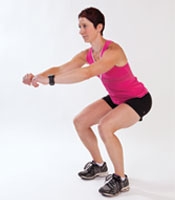
Resistance exercise may be the key to keeping our brains healthy and fully functioning as we age. Learn how to exercise to improve brain acuity.
As a fitness instructor I am often asked by my students if fitness and fitness classes can stimulate thinking. Some of them have older relatives whose activity levels are decreasing and who are becoming more at risk for the onset of dementia.
A fitness icon
My response is to ask them if they have heard of Jack LaLanne—the US fitness guru and vegetable juice machine star of late-night infomercials—who ran his business and was as sharp as a tack until the day he died in 2011 at the age of 96. His secret to youth was his full-time commitment to fitness.
“Jack was the guy I used to watch on TV doing exercises in the ’50s”, I explain.
“He’s the one who got me into this business. I came home from school and found all the neighbourhood mums gathered around the television saying, ‘I’m feeling muscles I never knew I had.’”
He made me want to get a job where I could be a fitness icon to women, so I became a fitness instructor.
Physical activity is good for the brain
There is a direct relationship between physical activity and mental acuity among older adults. A recent meta-analysis of prospective studies reported that exercise may improve mental functions among seniors with dementia or mild cognitive impairment—and may also improve spatial memory among seniors in general. The analysis also noted that animal research shows that exercise generates trophic factors that improve brain functioning—and that exercise facilitates brain connections.
Other animal studies suggest exercise appears to change brain structure, prompting the growth of new nerve cells and blood vessels. Exercise increases the production of neurochemicals that assist the growth, differentiation, survival and repair of brain cells.
A study conducted at the University of British Columbia (UBC) in Canada followed 86 women aged 70 to 80 years with mild cognitive impairment. Some were given hour-long sessions of aerobic training, while others were subjected to hour-long resistance training. As a control, some took hour-long balance and toning classes. All participants exercised twice weekly.
Improvements in cognition were noted in both the aerobic and resistance training groups after six months. Researchers found evidence that resistance training significantly improved associative memory performance. Impaired associative memory is often a warning sign of the early stages of Alzheimer’s disease.
In another recent study, researchers noted that twice-weekly resistance training sessions had positive effects on both behavioural performance and blood flow in the cortex. The researchers suggest that these benefits provide a good complement to the positive effects that aerobic exercise has on selective attention among seniors.
A group of researchers also studied 154 seniors—19 men and 135 women aged 62 to 95. The participants were placed into one of three groups: general group exercise, flexibility and relaxation and no exercise. After six months, participants in the general exercise group performed better on cognitive tests for fluid intelligence, which involves abstract thought and problem solving, and showed improvements in aspects of mood and depression.
In short, aerobics has many benefits; however, if you are looking to enhance brain function and ward off dementia, you will need progressive resistance training as well.
Exercises
Here are a few things you can do to stay physically active as you get older.
- Try to exercise 30 minutes per day—and try to dedicate every other session to resistance training.
- Find a class for older adults at your local neighbourhood house or community centre. You’ll find people of all fitness levels doing something they really look forward to—having fun!
- Use your arms while you walk. With each step, raise your arms over your head as if you are doing military presses for your shoulders. Add elbow presses for your chest and rowing exercises for your upper back. Do combinations of these while walking and watch the kilometres fly by.
- Try some isometric exercises where the muscle carries a load but stays the same length. In the kitchen, hook your fingers under the benchtop and pull up. This will strengthen your biceps. But if you hear a loud creaking sound, stop! That sound is the bench separating from the cabinet—and you’ll have to use all of that newfound intelligence to design a new kitchen.
- Get on the ball. The stability ball can provide hours of unbridled mirth. Use it for strengthening exercises such as crunches—and as a device to chase the grandkids around the house.
Here are some recommended progressive resistance exercises:
Squat:

(works the quads, glutes, hamstrings and core)
Stand with your legs hip-width apart with your spine in a neutral position. Bend your knees and lower yourself one-third of the way down. Go up for 2 seconds and down for 2 seconds. Do this for 3 sets of 8 repetitions.
Reverse lunge:

(works the quads, glutes, hamstrings and core)
Stand with your legs hip-width apart. Lunge one leg backwards and lower your body until your forward thigh is parallel to the floor. After a couple of seconds, slowly return your back leg to the starting position and repeat with your other leg. Add weights as you get used to the exercise. Do this for 3 sets of 8 repetitions.
Chest press:

(works the chest)
Put a resistance tube behind your back and under your arms. Press the handles away from you so you can feel the resistance of the tube. Do this for 3 sets of 8 repetitions.
Standing row:

(works the upper back, shoulders and arms)
Use a resistance tube hooked onto a wall. Hold the tube and pull it back until your elbows approach a 90-degree bend. Do this for 3 sets of 8 repetitions. And don’t attach the tube to a door, as someone is bound to come through it—with surprising results.




